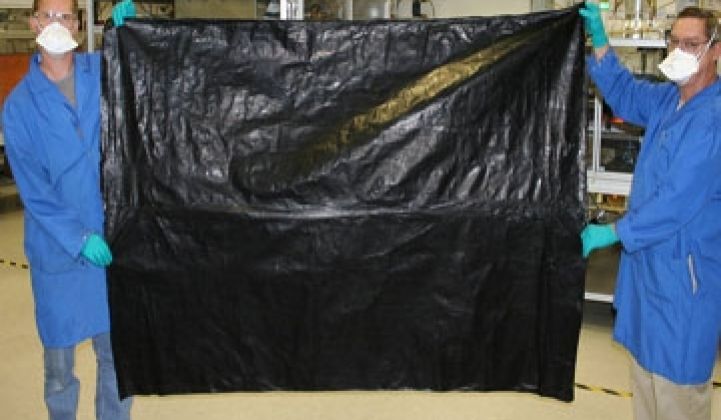Single-walled-carbon nanotubes have properties that make them sound like they came from a science fiction novel.
They're stronger than steel, they conduct electricity and heat better than metals, they flex like plastics, and they're also incredibly lightweight. They can even be used to desalinate water.
Unfortunately, single-walled-carbon nanotubes have typically been incredibly expensive to make and difficult to incorporate into the regimentation of mass manufacturing. As this 2003 article shows, commercial viability always seems to be on the horizon.
Nanocomp Technologies, though, says it has come up with a manufacturing process that can get around a good portion of these problems. It grows comparatively long single-walled nanotubes – they can be measured in millimeters rather than microns or nanometers. Then, these nanotubes can be weaved into cords or sheets. These cords and sheets in turn can be fashioned into insulators or potentially wires. The picture above depicts what looks like a lawn and garden bag sliced open, but it is in fact a sheet of single-walled nanotubes.
"It looks like a black thread. We're making kilometers of it," said CEO Peter Antoinette. "We also make four-foot by eight-foot sheets every shift."
Although nanotubes can conduct electricity quite well, the company is initially pitching its product as an insulator for satellites and aircraft because the material weighs 90 percent less than current industry-standard materials. Cutting aircraft weight, of course, would lower fuel consumption.
"It takes $100,000 a pound to get something into orbit," he said. "We can save 200 to 500 pounds per satellite. In a 787 we can save over 8,000 pounds of weight."
Nanotube sheets could also be used to shield components from electromagnetic interference. "You could cover an airplane with it," Antoinette added.
Later, Nanocomp will try to sell it as a replacement for copper in wiring. Wire replacement would take years of scaling up manufacturing and passing reliability tests. (The qualification cycle for insulation, while difficult, is less intense.) Nonetheless, the potential gains are there. A substantial portion of the infrastructure of the electrical grid exists to keep heavy power lines from sagging; sagging increase the cost and losses along the line. With nanotubes serving as insulators and/or conductors, power lines, you could see relatively taut lines strung along a sparse number of poles.
And the grid is getting older by the day.
"Fifty years from now, we are going to face a major rewiring problem," he said.
Nanocomp's basic technique could be called strength in numbers, huge numbers. The company first injects a fuel and carrier gas into a furnace, which extracts carbon molecules from gases into nanotubes. Its process leads to relatively long tubes.
"It looks like cotton candy but only it is black," he said. "[Nanotubes] haven't worked in the past because they were too short."
The nanotubes are then essentially deposited into insulators or cables sort of the way kids might make sand art at the state fair. To make sheets, nanotubes are deposited on a membrane on a rotating drum. A single thread-like cable might sport ten 17th nanotubes across its diameter.
At these volumes, chirality, which describes the relationship of atoms to one another in a nanotube, doesn't matter, he argued. Chirality has been a stumbling block for researchers trying to make nanotube transistors because a slight change in the spatial relationship of the atoms can change one nanotube from being an electrical insulator to a semiconductor or a conductor. But that's when you have one nanotube connecting to the other. When you have billions, paths emerge. Electrical transmission isn't perfectly ballistic (a term used to describe nanotube conductivity) but it's good.
Right now, Nanocomp "is not yet close in price to copper," Antoinette said, which sells for $4 a pound. Nanocomp currently hopes to scale up to an 11,000-square-foot factory. A facility that size would allow it to make "millions of kilometers" or 50,000 square meters of nanotubes. Nanotube sheets would still cost a few hundred dollars a pound at this point, but they would start riding a downward cost curve like standard carbon fiber.



